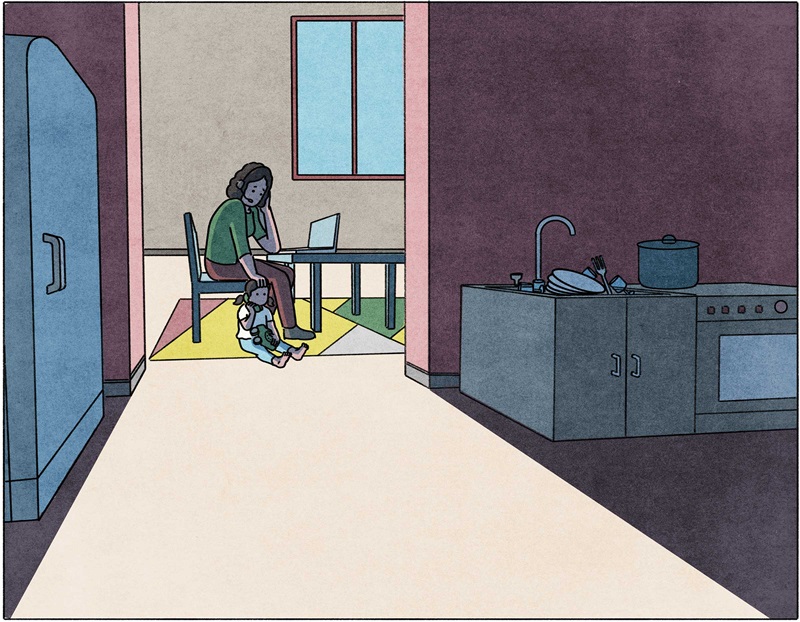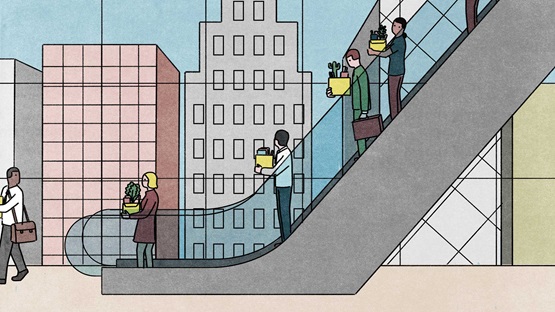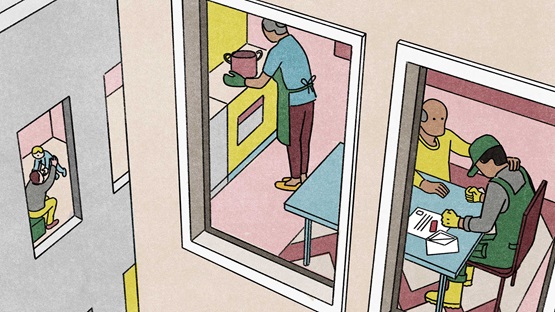
Over the past 18 months, newspapers have devoted many column inches to the challenges mothers have faced during the pandemic. And for good reason: As schools closed and the work environment shifted—businesses shuttered entirely, pivoted to work from home, or stayed on-site with large health risks—the perennial challenge parents confront to balance work and family grew even more complicated.
While there are many estimates of the number of mothers who exited the labor force during the pandemic, those simple statistics can’t say much about why. How much of the decline was due to changes in labor demand—a result of women’s disproportionate presence in sectors most hurt by the pandemic, such as retail? How much was due to labor supply—a result of health fears or the child care crunch imposed by school and daycare closures?
Former Opportunity & Inclusive Growth Institute visiting scholar Misty Heggeness, a research economist at the U.S. Census Bureau, has long been interested in using big data to study public policy and how gender affects economic outcomes. As we stare down year three of life in the shadow of COVID, she has sought to understand how the rocky road parents have traveled has impacted their decisions about work.
By analyzing data from the Current Population Survey, Heggeness and her co-author, Palak Suri, find evidence that there is a labor supply story at work, as they explain in the Institute Working Paper “Telework, Child Care, and Mothers’ Labor Supply.” In the first nine months of the pandemic, the labor force participation of mothers of school-age children fell 1.5 percentage points more than that of women without dependent children and 1.7 percentage points more than fathers.
In all, about 1.4 million fewer mothers were in the labor force in September 2021 than September 2019, Heggeness calculated. That’s a sizeable fraction of the approximately 11 million job openings in the fall of 2021.
To better understand which mothers were affected and why, Heggeness and Suri compare how work decisions of mothers in different work environments compare to others. Their findings showcase both the advantages as well as the limits of flexible work arrangements—and the reasons to think deeply as a society about how to make child care affordable and accessible for all.
The limits of multitasking
Conventional wisdom has long held that flexible work, particularly telework, helps mothers maintain paid employment. “I think a lot of us had the perception going into the pandemic that this forced mass conversion to remote work was really going to help parents manage the child care crisis,” Heggeness said. To test this idea, Heggeness and Suri track the labor force status of mothers, women without children, and fathers who work (or worked) in “telework compatible” or “on-site” occupations.
Because the option to work remotely often depends on education level, the economists make comparisons separately for workers with and without a college degree. They also account for whether there is another adult living in the household as well as the county and state of residence, as these variables all plausibly affect labor decisions.
To develop a nuanced understanding of mothers’ decisions about work, the economists consider several possible work statuses. “Labor force participation” captures whether someone is attached to the labor force either by holding a job or actively searching. But it’s a broad category, so they also look at whether someone is working, is on leave, or is unemployed and searching.
The economists then compare the work status of mothers with school-aged children to the status of women without children and fathers with school-aged children. Comparing the change in one group to the change in the other is a way to take into account factors affecting both groups—the pandemic recession, say—as well as the fact that the participation levels may have been different to start with.
By comparing moms in different types of occupations and with different levels of education, the economists find patterns in the data that suggest several takeaways about mothers’ experiences with work and child care during the pandemic. For on-site occupations, mothers with less than a college degree were more likely to take leave than women without children. Mothers with a college degree working on-site, however, did not differ in their work status from women without children. Mothers with less than a college degree were less likely to be able to afford child care or have another household member who could watch the children, and so they could not continue to work at the same rates, the economists theorize. Mothers with a college degree, many of them “essential” workers, such as ER doctors, were better able to find and afford child care or had another household member who could watch the children, and so they continued to work.
Interestingly, the pattern switches for mothers in telework-compatible occupations: For mothers with less education, their work patterns do not look different from those of women without children. Their income is likely critical to their household, and because they were home with their children, it was possible to continue to work despite the significant challenges. Mothers with a college degree in telework-compatible occupations, meanwhile, were more likely to take leave from work or leave the labor force entirely than women without children or than fathers with college degrees.
“When you're trying to work from home and everybody else is in your home, you're playing multiple roles,” Heggeness explained. “You're playing the role of employee, boss, colleague, whatever it might be—and then you're also playing the role of mother, spouse, adult child, if you have elder parents living with you. And that is really just exhausting. One of the things our paper showed was that for moms who actually had to leave their home for work, like go to the hospital or go on duty as a police officer—somehow they found a way to calibrate child care and they were able to work in a way that didn't disproportionally affect them relative to their workmates.”
Rethinking child care
Heggeness and Suri’s research tells two stories. It is a story of resiliency: That so many mothers stayed in the labor force in the face of the health risks and child care demands during the pandemic points to the importance of mothers’ income for many households’ economic survival. In addition, at a time when more women attain higher education than ever before, it’s also the case that many are deeply attached to their professional identity, Heggeness said. So, many mothers continued to work—inside the home and out, while caring for children or worrying about schools’ quarantine calls—but doing so likely took a toll on their mental health.
Which is why the labor force participation story of mothers during the pandemic is also a child care story—a story that has not alleviated as the pandemic wears on and on and on. In fact, the gap in labor force participation between mothers and fathers that is attributable to the pandemic’s child care challenges has increased: In September 2020, mothers’ labor force participation had declined 1.5 percentage points more than fathers; by September 2021, the economists calculate that gap had grown to 2.0 percentage points, a 33 percent increase.
While Heggeness and Suri focused on parents of school-aged children, their research has implications for the child care challenges parents of younger children faced long before the pandemic began and will face after. In the United States, child care is a labor market friction—“a barrier to the optimal allocation of labor,” as Dartmouth economics professor Elizabeth Cascio put it. The cost of child care is a major reason for the barrier, with high-quality centers costing between $15,000 and $20,000 a year per child on average, Cascio reported.
These costs are the result of regulations—important regulations—that require low staff-to-child ratios. As a result, 60 percent or more of child care center costs go to staff salaries, according to RAND senior economist Lynn Karoly. To be as affordable as possible, centers squeeze salaries, making child care one of the lowest-wage industries in the country, and yet still too costly for many families.
Even when parents are able to pay, child care can be difficult to obtain. “There is a problem when you have people having to put their names on wait lists for childcare before they’re even pregnant or before the child is even born,” Heggeness said.
For these reasons, child care is “the most broken business in America,” according to Bloomberg, and solving the crisis might require us to stop thinking of it as a business at all.
“I think we would all be better off if we thought about child care as a public good,” Heggeness said. “It has lots of benefits to the broad society. It frees up able-bodied, working age adults to be able to be productive in the economy. It also provides a basic level of developmentally appropriate care and education for young humans who, eventually, after they finish all of their education and become adults at the age of 18, will be the next generation of workers in our society.”
This is, of course, how we think about education once a child turns 5, where we use taxes to pay for all children’s education. But there is very limited public assistance to pay for child care, and unlike for college, families can’t borrow (without collateral) for preschool, Cascio pointed out.
While child care is an important labor market friction for parents, it’s not the only one. The U.S. lacks numerous employer-side policies other countries have to help working parents, including parental leave and paid sick leave. Often overlooked in this suite of policies is the right to work part time and protections for part-time workers against discrimination, RAND economist Kathryn Anne Edwards said. And then there’s the fact that the timing and structure of school days and school years were not set up for working parents, Heggeness observed.
The consequences of the pandemic’s child care shock to school-aged kids—and the lack of affordable, accessible child care in the United States more broadly—matter because economic research shows that earnings remain depressed for years, even decades, after periods of non-employment, particularly long periods. For mothers, this means less money to live on, less to invest in their children or their retirement down the road.
“But even mothers who stayed in the labor force could have been harmed by the pandemic,” Cascio said. Mothers have been—continue to be—stretched thin as they seek to balance parenting and paid employment under new, challenging work conditions. Some were forced to new heights of multitasking—and some who could afford it chose instead to leave their jobs, as the flexibility that telework allows ran up against the rigidity and intensity of child care.
“Just because child care constraints have not created a mass exodus of mothers does not mean that child care is not an essential component of the recovery,” Heggeness stated. And while understanding the full impact of the pandemic will likely take decades, society doesn’t need to wait that long to start making the incredible balancing act mothers face a little bit easier.
This article is featured in the Spring 2022 issue of For All, the magazine of the Opportunity & Inclusive Growth Institute
Lisa Camner McKay is a senior writer with the Opportunity & Inclusive Growth Institute at the Minneapolis Fed. In this role, she creates content for diverse audiences in support of the Institute’s policy and research work.




